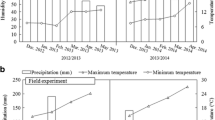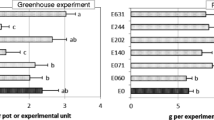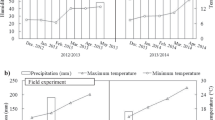Abstract
Kentucky bluegrass (Poa pratensis L.) is a very common grass species with a wide distribution, including in Mediterranean areas. The objective of this study was to investigate the effects of non-clavicipitaceous fungal endophytes on forage production by P. pratensis, and on the nutritive value and mineral status of its herbage. Plants were inoculated with each of eight endophytic species and grown under greenhouse conditions. After 3 months, the plants were harvested and dried before evaluating the following parameters: dry mass of herbage and roots, crude protein content, neutral detergent fibre content, and mineral contents in herbage. The results showed that endophytes affected the biomass yield (herbage and roots), fibre content, and mineral contents in the forage. Compared with controls, plants inoculated with Stemphylium globuliferum showed the highest herbage and root biomass values, whilst those inoculated with Embellisia leptinellae and S. globuliferum showed reduced fibre contents in herbage. Plants infected with Epicoccum nigrum and S. globuliferum showed increased herbage concentrations of calcium, magnesium, molybdenum, and titanium. These results demonstrate that inoculation of Poa pratensis with endophytes can increase its biomass yield and the nutritive value of its herbage. Therefore, endophyte inoculation may be a useful strategy to reduce nutrient deficiencies in P. pratensis forage.


Similar content being viewed by others
References
Ahlholm JU, Helander M, Lehtimäki S, Wäli P, Saikkonen K (2002) Vertically transmitted fungal endophytes: different responses of host-parasite systems to environmental conditions. Oikos 99:173–183
Assuero SG, Tognetti JA, Colabelli MR, Agnusdei MG, Petroni EC, Posse MA (2006) Endophyte infection accelerates morpho-physiological responses to water deficit in tall fescue. N Z J Agric Res 49:359–370
Azliza IN, Hafizi R, Nurhazrati M, Salleh B (2014) Production of major mycotoxins by Fusarium species isolated from wild grasses in Peninsular Malaysia. Sains Malays 43:89–94
Bartholdy BA, Berreck M, Haselwandter K (2001) Hidroxamate siderophore synthesis by Phialocephala fortinii, a typical dark septate fungal root endophyte. BioMetals 14:33–42
Bischoff KM, Wicklow DT, Jordan DB, de Rezende ST, Liu S, Hughes SR, Rich JO (2009) Extracellular hemicellulolytic enzymes from the maize endophyte Acremonium zeae. Curr Microbiol 58:499–503
Bremner JM, (1996) Chapter 37 –Nitrogen –Total: In Methods of Soil Analysis. Part 3. Chemical Methods. SSSA Book Series no. 5
Clarke BB, White JF, Hurley H, Torres MS, Sun S, Huff DR (2006) Endophyte mediated suppression of dollar spot disease in fine fescues. Plant Dis 90:994–998
Cripps MG, Edwards GR (2013) Fungal endophytes of a forage grass reduce faecal degradation rates. Basic Appl Ecol 14:146–154
Croce P, De Luca A, Mocioni M, Volterrani M, Beard JB (2001) Warm season turfgrass species and cultivar characterizations for a Mediterranean climate. Int Turfgrass Soc Res J 9:855–859
de Lima Fávaro LC, Sebastianes FL, Araújo WL (2012) Epicoccum nigrum P16, a sugarcane endophyte, produces antifungal compounds and induces root growth. PLoS ONE 7, e36826
Debbab A, Aly AH, Edrada-Ebel R, Wray V, Müller WE, Totzke F, Zirrgiebel U, Schächtele C, Kubbutat MH, Lin WH, Mosaddak M, Hakiki A, Proksch P, Ebel R (2009) Bioactive metabolites from the endophytic fungus Stemphylium globuliferum isolated from Mentha pulegium. J Nat Prod 72:626–631
Dürr GH, Kunelius HT, Drapeau R, McRae KB, Fillmore SAE (2005) Herbage yield and composition of Kentucky bluegrass (Poa pratensis L.) cultivars under two harvest systems. Can J Plant Sci 85:631–639
Faeth SH, Hayes CJ, Gardner DR (2010) Asexual endophytes in a native grass: radeoffs in mortality, growth, reproduction, and alkaloid production. Microb Ecol 60:496–504
Fletcher LR, Garthwaite I, Towers NR (1993) Ryegrass staggers in the absence of lolitrem B. In: Hume DE, Latch GCM, Easton HS (eds) Proceedings of the Second International Symposium on Acremonium/Grass Interactions. Palmerston North, New Zealand, pp 119–121
Fuchs B, Krischke M, Mueller MJ, Krauss J (2013) Peramine and lolitrem B from endophyte-grass associations cascade up the food chain. J Chem Ecol 39:1385–1389
Hamilton CE, Bauerle TL (2012) A new currency for mutualism? Fungal endophytes alter antioxidant activity in hosts responding to drought. Fungal Divers 54:39–49
Hay RKM, Heide OM (1983) Specific photoperiodic stimulation of dry matter production in a high latitude cultivar of Poa pratensis. Physiol Plant 57:135–142
Hesse U, Schöberlein W, Wittenmayer L, Förster K, Diepenbrock W, Merbach W (2005) Influence of water supply and endophyte infection (Neotyphodium spp.) on vegetative and reproductive growth of two Lolium perenne L. genotypes. Eur J Agron 22:45–54
Hodge A (2004) The plastic plant: root responses to heterogeneous supplies of nutrients. New Phytol 162:9–24
Holman JD, Hunt C, Thill D (2007) Structural composition, growth stage, and cultivar affects on Kentucky bluegrass forage yield and nutrient composition. Agron J 99:195–202
Iannone LJ, Pinget AD, Nagabhyru P, Schardl CL, De Battista JP (2011) Beneficial effects of Neotyphodium tembladerae and Neotyphodium pampeanum on a wild forage grass. Grass Forage Sci 67:382–390
Johnson LJ, Koulman A, Christensen M, Lane GA, Fraser K, Forester N, Johnson RD, Bryan GT, Rasmussen S (2013) An extracellular siderophore is required to maintain the mutualistic interaction of Epichloë festucae with Lolium perenne. PLoS Pathog 9, e1003332
Krueger GL, Morris TK, Suskind RR, Widner EM (1985) The health effects of aluminum compounds in mammals. Crit Rev Toxicol 13:1–24
Lawrence DP, Park MS, Pryor BM (2011) Nimbya and Embellisia revisited, with nov. comb. for Alternaria celosiae and A. perpunctulata. Mycol Prog 11:799–815
Li Y, Xia LQ, Wang YN, Liu XY, Zhang CH, Hu TL, Cao KQ (2013) The inhibitory effect of Epicoccum nigrum strain XF1 against Phytophthora infestans. Biol Control 67:462–468
Likar M, Regvar M (2013) Isolates of dark septate endophytes reduce metal uptake and improve physiology of Salix caprea L. Plant Soil 370:593–604
Mahadevakumar S, Jayaramaiah KM, Janardhana GR (2014) First report of leaf spot disease caused by Epicoccum nigrum on Lablab purpureus in India. Plant Dis 98:284
Martini M, Musetti R, Grisan S, Polizzotto R, Borselli S, Pavan F, Osler R (2009) DNA-dependent detection of the grapevine fungal endophytes Aureobasidium pullulans and Epicoccum nigrum. Plant Dis 93:993–998
Matthews JW, Clay K (2001) Influence of fungal endophyte infection on plant-soil feedback and community interactions. Ecology 82:500–509
Murphy WM, Silman JP, McCrory LE, Flack SE, Schmitt AL, Mzamane NM (1997) Management of natural Kentucky bluegrass-white clover pasture. Am J Altern Agric 12:140–142
Oberhofer M, Gusewell S, Leuchtmann A (2014) Effects of natural hybrid and non-hybrid Epichloë endophytes on the response of Hordelymus europaeus to drought stress. New Phytol 201:242–253
Oliveira JA, Rottinghaus GE, Gonzalez E (2003) Ergovaline concentration in perennial ryegrass infected with a lolitrem B-free fungal endophyte in north-west Spain. N Z J Agric Res 46:117–122
Oliveira JA, González E, Castro P, Costal L (2004) Effects of endophyte infection on dry matter yield, persistence and nutritive value of perennial ryegrass in Galicia (north-west Spain). Span J Agric Res 2:558–563
Olsen S, Cole C, Watanabe F, Dean L (1954) Estimation of available phosphorus in soils by extraction with sodium bicarbonate. USDA Circular Nr 939, US Gov. Print. Office, Washington, D.C
Prior R, Görges K, Yurkov A, Begerow D (2014) New isolation method for endophytes based on enzyme digestion. Mycol Prog 13:849–856
Przybył K (2002) Fungi associated with necrotic apical parts of Fraxinus excelsior shoots. For Pathol 32:387–394
Reader RJ, Wilson SD, Belcher JW, Wisheu I, Keddy PA, Tilman D, Morris EC, Grace JB, McGraw JB, Olff H, Turkington R, Kelin E, Leung Y, Shupley B, van Hulst R, Johansson ME, Nilsson C, Gurevitch J, Grigulis K, Beisner BE (1994) Plant competition in relation to neighbor biomass: an intercontinental study with Poa pratensis. Ecology 75:1753–1760
Rodriguez RJ, White JF, Arnold AE, Redman RS (2009) Fungal endophytes: diversity and functional roles. New Phytol 182:314–330
Santamaría O, Smith DR, Stanosz GR (2012) Interaction between Diplodia pinea or Diplodia scrobiculata and fungal endophytes isolated from pine shoots. Can J For Res 42:1819–1826
Santamaría O, Rodrigo S, Poblaciones MJ, Olea L (2014) Fertilizer application (P, K, S, Ca and Mg) on pasture in calcareous dehesas: effects on herbage yield, botanical composition and nutritive value. Plant Soil Environ 60:303–308
Soleimani M, Afyuni M, Hajabbasi MA, Nourbakhsh F, Sabzalian MR, Christensen JH (2010) Phytoremediation of an aged petroleum contaminated soil using endophyte infected and non-infected grasses. Chemosphere 81:1084–1090
Spiering MJ, Greer DH, Schmid J (2006) Effects of the fungal rndophyte, Neotyphodium lolii, on net photosynthesis and growth rates of perennial ryegrass (Lolium perenne) are independent of In Planta endophyte concentration. Ann Bot 98(2):379–387
Strobel GA, Hess WM, Ford E, Sidhy RS, Yang X (1996) Taxol from fungal endophytes and the tissue of biodiversity. J Ind Microbiol 17:417–423
Suttle NF (2010) Mineral nutrition of livestock, 4th edn. CABI Publishing, Wallingford
Tanaka A, Takemoto D, Chujo T, Scott B (2012) Fungal endophytes of grasses. Curr Opin Plant Biol 15:462–468
Thom ER, Popay AJ, Waugh CD, Minnee EMK (2013) Impact of novel endophytes in perennial ryegrass on herbage production and insect pests from pastures under dairy cow grazing in northern New Zealand. Grass Forage Sci 69:191–204
Underwood EJ (1981) The mineral nutrition of livestock, 2nd edn. Commonwealth Agricultural Bureaux, Farnham Royal
Weber RWS, Dralle N (2013) Fungi associated with blossom-end rot of apples in Germany. Eur J Hortic Sci 78:97–105
White JF Jr (1988) Endophyte-host associations in forage grasses. XI. A proposal concerning origin and evolution. Mycologia 80:442–446
Zabalgogeazcoa I, García-Ciudad A, Vázquez de Aldana BR, García-Criado B (2006) Effects of the infection by the fungal endophyte Epichloë festucae in the growth and nutrient content of Festuca rubra. Eur J Agron 24:374–384
Zabalgogeazcoa I, García-Ciudad A, Leuchtmann A, Vázquez de Aldana BR, García-Criado B (2008) Effects of choke disease in the grass Brachypodium phoenicoides. Plant Pathol 57:467–472
Zhang J, Jia W, Yang J, Ismail AM (2006) Role of ABA in integrating plant responses to drought and salt stresses. Field Crop Res 97:111–119
Acknowledgments
This study was funded by Project AGL2011-27454, granted by the Ministry of Economy and Competitiveness of Spain (the former Ministry of Science and Innovation) and by the European Regional Development Fund (ERDF). We would like to thank Teodoro García-White, Natalia Hernández and Pablo Romero for their invaluable help with the technical work.
Author information
Authors and Affiliations
Corresponding author
Additional information
Section Editor: Dominik Begerow
Rights and permissions
About this article
Cite this article
Lledó, S., Rodrigo, S., Poblaciones, M.J. et al. Biomass yield, mineral content, and nutritive value of Poa pratensis as affected by non-clavicipitaceous fungal endophytes. Mycol Progress 14, 67 (2015). https://doi.org/10.1007/s11557-015-1093-4
Received:
Revised:
Accepted:
Published:
DOI: https://doi.org/10.1007/s11557-015-1093-4




